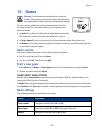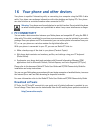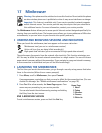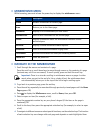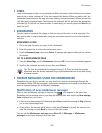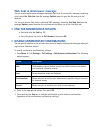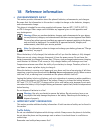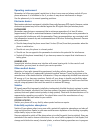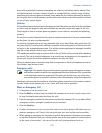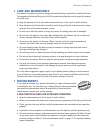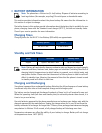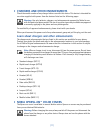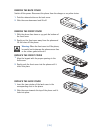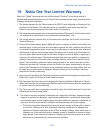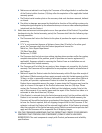
[ 73 ]
Reference information
Areas with a potentially explosive atmosphere are often but not always clearly marked. They
include below deck on boats; chemical transfer or storage facilities; vehicles using liquefied
petroleum gas (such as propane or butane); areas where the air contains chemicals or particles,
such as grain, dust, or metal powders; and any other area where you would normally be advised
to turn off your vehicle engine.
Vehicles
Only qualified personnel should service the phone or install the phone in a vehicle. Faulty installation
or service may be dangerous and may invalidate any warranty which may apply to the unit.
Check regularly that all wireless phone equipment in your vehicle is mounted and operating
properly.
Do not store or carry flammable liquids, gases or explosive materials in the same compartment
as the phone, its parts or enhancements.
For vehicles equipped with an air bag, remember that an air bag inflates with great force. Do
not place objects, including both installed or portable wireless equipment in the area over the
air bag or in the air bag deployment area. If in-vehicle wireless equipment is improperly installed
and the air bag inflates, serious injury could result.
FCC regulations prohibit using your phone while in the air. Switch off your phone before boarding
an aircraft. The use of wireless telephones in an aircraft may be dangerous to the operation of
the aircraft, disrupt the wireless telephone network, and may be illegal.
Failure to observe these instructions may lead to suspension or denial of telephone services to
the offender, legal action or both.
Emergency calls
Important:
This phone, like any wireless phone, operates using radio signals, wireless,
and landline networks as well as user-programmed functions. Because of this, connections
in all conditions cannot be guaranteed. Therefore you should never rely solely upon
any wireless phone for essential communications (for example, medical emergencies).
Emergency calls may not be possible on all wireless phone networks or when certain network
services and/or phone features are in use. Check with local service providers.
Make an Emergency Call
1
If the phone is not on, switch it on.
2
Press the
End
key as many times as needed (for example, to exit a call, to exit a menu, etc.)
to clear the display and ready the phone for calls.
3
Enter the emergency number for your present location (for example, 911 or any other official
emergency number—emergency numbers vary by location).
4
Press the
Send
key.
• If certain features are in use, you may first need to turn those features off before you can
make an emergency call. Consult this user guide and your local cellular service provider.
• When making an emergency call, remember to give all the necessary information as accurately
as possible. Remember that your wireless phone may be the only means of communication
at the scene of an accident - do not end the call until given permission to do so.



